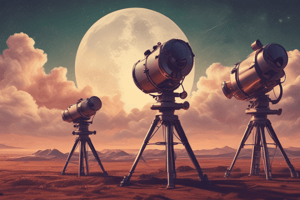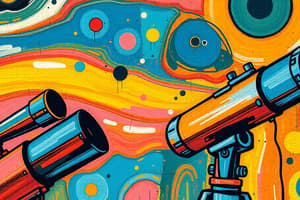Podcast
Questions and Answers
What determines the ability of a telescope to collect light?
What determines the ability of a telescope to collect light?
- The type of lens used
- The aperture diameter (correct)
- The magnification power
- The length of the telescope
What is the main advantage of a larger aperture in a telescope?
What is the main advantage of a larger aperture in a telescope?
- Increased magnification
- Portability
- Lighter telescope
- Brighter final image (correct)
What is the main difference between a telescope and binoculars?
What is the main difference between a telescope and binoculars?
- Telescopes have one lens, binoculars have two
- Telescopes are handheld, binoculars are not
- Binoculars use both eyes, telescopes use one eye (correct)
- Telescopes are used for astronomy, binoculars are for terrestrial use
What is the purpose of the objective lens assembly in a binocular?
What is the purpose of the objective lens assembly in a binocular?
What is a key design consideration for binoculars?
What is a key design consideration for binoculars?
Why did the design of binoculars take longer to evolve than telescopes?
Why did the design of binoculars take longer to evolve than telescopes?
What is the primary function of the eyepiece lens assembly in binoculars?
What is the primary function of the eyepiece lens assembly in binoculars?
What is the main difference between Porro-prism and Roof-prism binoculars?
What is the main difference between Porro-prism and Roof-prism binoculars?
What are magnetism and electricity aspects of?
What are magnetism and electricity aspects of?
Who discovered that a magnet has two magnetic poles: NORTH and SOUTH poles?
Who discovered that a magnet has two magnetic poles: NORTH and SOUTH poles?
Who proposed that the Earth is a giant magnet?
Who proposed that the Earth is a giant magnet?
Who discovered that a changing magnetic field produces a current in a coil of wire?
Who discovered that a changing magnetic field produces a current in a coil of wire?
Flashcards are hidden until you start studying
Study Notes
Telescopes
- Optical devices designed to make distant objects appear closer.
- Composed of an objective lens in refractors and a primary mirror in reflectors.
- Light-gathering ability is determined by the diameter of the lens or mirror, known as the aperture.
- A larger aperture collects more light, resulting in a brighter image.
- Magnification is influenced by the lens combination, but aperture is more critical for image quality.
Binoculars
- Binocular telescopes consist of two identical mirrors, allowing for binocular vision.
- Design involves multiple considerations:
- Two telescopes are needed for magnification.
- Matching magnification between lenses.
- Erect image display.
- Must be handheld and focusable, preferably jointly.
- Parallel optical axes and adjustable interpupillary separation.
Binocular Optical System
- Comprises three main parts:
- Objective Lens Assembly: Gathers light and forms an image.
- Eyepiece Lens Assembly: Examines the image formed by the objective lenses, includes a focusing mechanism.
Types of Binoculars
- Porro-prism Binoculars: Characterized by offset objective lens tubes and angled prisms.
- Roof Prism Binoculars: Feature straight tubes, resulting in a more compact design.
Magnetism
- A force produced by the motion of electrons within matter.
- Represents one aspect of electromagnetism, a fundamental force in nature.
Electricity
- Defined as the flow of electrical power or charge, closely related to magnetism.
Electromagnetism
- A physics branch investigating electromagnetic forces between charged particles.
Timeline of Magnetism
- Ancient World: Knowledge of magnetism among Greeks, Romans, and Chinese; development of geomantic compasses in China; lodestones named after Manisa, Turkey.
- 13th Century: Petrus Peregrinus documented a magnet's magnetic field and identified North and South poles.
- 17th Century: William Gilbert published De Magnete, proposing the Earth as a giant magnet.
- 18th Century: John Michell and Charles-Augustin de Coulomb studied magnetic forces; Coulomb researched electricity but did not link it with magnetism.
- 19th Century: Key figures like Hans Christian Oersted demonstrated the link between electricity and magnetism, while Faraday discovered that changing magnetic fields can induce electric currents.
Studying That Suits You
Use AI to generate personalized quizzes and flashcards to suit your learning preferences.




